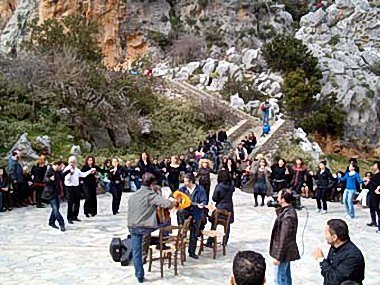The forgotten “Empyrrikios” dance of Crete
Over 600 visitors attended the first official presentation at Zoniana of the forgotten old “empyrrikios” dance, recorded and studied on Mount Psiloritis. The presentation was by researcher and dance teacher Yannis Panayiotakis and the members of the School of Folk Arts, which examines dances and their attributes.

The dance was danced by dancers of the School of Folk Arts with the participation of many of those present. Over ten other old and mostly forgotten dances of Crete were also demonstrated, to the sound of the lyre played by Manolis Parasyris and Theocharis Nikiforou. The event concluded with a concert lasting many hours and dancing by the hundreds of visitors, who also had the opportunity of visiting the Waxworks Museum and Zoniana Cave.
The “empyrrikios” dance of Crete was discovered in Platania in Amari, and was forgotten until recently. It seems that it was already considered a rarity from the mid-20th century or earlier.
The name “empyrrikios” is derived from the Pyrrichios or Pyrrhic dance, the most famous dance of ancient Greece. The steps are reminiscent of the “siganos” danced today on east Crete, but the dance itself is lively, with a completely different rhythm and style.
As recorded in the collective memory of the village, it was usually danced in a circle, but the two lead dancers could break away at will and dance as a pair. This feature is another point of similarity with the Pyrrhic dance, and also with the strange armed dance recorded by the French traveller Pierre Belon in Sfakia in 1549.
The Pyrrhic or Pyrriche was a stately, fast and impressive dance. It was common in Doric cities and its aim was to cultivate martial virtue. It was danced either singly or in pairs, by dancers armed with shield and spear or sword, imitating warriors’ attacks and defences. The dance was very lively, with strange twists of the body. It was thought to be the dance of the ancient Curetes.
In Greek mythology, the goddess Rhea taught it to the Curetes so they could dance around the newborn Zeus in the Idaean Cave, clashing their spears on their shields, to cover the baby’s cries and hide him from his father Cronus, who ate his children to prevent them usurping his throne.
A very important find, possibly connected to the empyrrikios, recently came to light in the excavation of ancient Syvrita, very close to Platania: a clay krater (a large vessel for mixing wine and water) painted with three dancing warriors, the first depiction of the Pyrrhic dance found on a Greek vase.